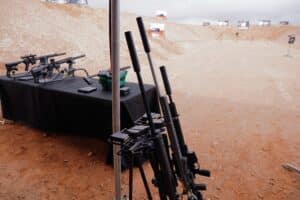Outside of gun rights for non-violent felons, few Second Amendment issues have divided the lower courts as much in recent years as age restrictions for certain adults. Now, the country’s largest gun-rights organization is asking the Supreme Court to settle the dispute once and for all.
The National Rifle Association (NRA) recently filed a petition for certiorari in the case NRA v. Glass. The petition asks the Court to review and reverse an Eleventh Circuit Court of Appeals decision from March that upheld Florida’s ban on gun sales to adults under the age of 21.
“A fundamental incident of adulthood in America is the enjoyment of constitutional rights, including the right to defend yourself, your family, and your home with common firearms,” the NRA petition reads. “Stripping away an 18-year-old adult’s Second Amendment rights is thus fundamentally irreconcilable ‘with the principles that underpin the Nation’s regulatory tradition,’ and the Court should grant the writ and reverse.”
The request comes at what seems like an opportune time for enticing the justices to weigh in. As the court of last resort, the Supreme Court tends to avoid hearing issues unless necessary to resolve an active controversy among the lower courts. The Roberts Court has been particularly choosy in recent years.
Still, age-based gun restrictions appear to be a prime candidate for intervention.
In just the last three years since the Court handed down its Bruen decision and its new Second Amendment test, federal appeals courts have split three to two on the constitutionality of restricting gun rights for 18–to-20-year-olds. While the Third, Fifth, and Eighth Circuits have all issued rulings striking down laws that limit the purchase or carrying of firearms for that age group, the Tenth and Eleventh Circuits have upheld total sales bans for them.
Furthermore, the issue is a good vehicle to not only address the threshold question of when people gain full Second Amendment rights, but also a host of additional hot-button questions at the periphery that could assist courts and litigants alike in future gun cases.
For example, one of the key factors that has led courts to arrive at opposite sides of the issue has been the historical period emphasized when searching for analogous regulations to support modern restrictions. Those who have upheld restrictions tended to rely more heavily on Reconstruction-era history when state-level age restrictions began to appear in earnest. Meanwhile, those who have struck down modern age limits have looked more toward the Founding Era, when not only were there precious few age-based gun restrictions, but laws like the Militia Act actually required certain 18-year-olds to be armed.
The Supreme Court implied, but did not say definitively, that it preferred Founding-era history when it laid out its text, history, and tradition test in Bruen. Accepting Glass would allow it to flesh out its position, which would necessarily affect every other Second Amendment case moving forward.
Additionally, the case also allows the justices to address the issue of unenumerated, but implied, conduct associated with the right to keep and bear arms—namely, commercial sales.
In its ruling upholding Colorado’s total sales ban for young adults, for instance, the Tenth Circuit relied on language from the Supreme Court’s Heller opinion referring to “laws imposing conditions and qualifications on the commercial sale of arms” as “presumptively lawful.” It took that to imply that Colorado’s ban did not even “implicate the plain text of the Second Amendment,” and thus upheld it without any historical inquiry.
As Florida’s law is also a sales ban, presumably the Court could clear up its Heller dicta by explaining the extent to which the Second Amendment protects commercial activity. Especially since that argument has found its way into other legal contexts, including waiting periods, enhanced background checks, and licensure requirements for gun sellers.
While the case has a lot going for it in terms of making a compelling cert grant candidate, the Supreme Court’s appetite for it is still very much an open question. The justices recently ducked one opportunity to address age limits when they denied Minnesota’s request to revisit the Eighth Circuit’s ruling on gun carry for 18-to-20-year-olds last month. And they’ve continued to clear their plate of other pending Second Amendment challenges in recent weeks.
One factor that could tip the scales is whether the Department of Justice (DOJ) chooses to take a position. Under the Trump Administration, it has shown a willingness to step in and urge the Court to take up some Second Amendment challenges. It could do so again under its new “pro-Second Amendment” posture.
At the same time, it’s also sometimes shown the opposite inclination. And age limits might be a sore spot for the DOJ. One of the cases driving the current circuit split on age limits came out of the Fifth Circuit, where a three-judge panel ruled in January that the federal 21-year-old age minimum for handgun sales from licensed dealers violates the Second Amendment.
The agency has been ambivalent on that issue thus far. It has twice asked for an extension of time from the Supreme Court so it can decide whether or not it wants to ask for an appeal. It has repeatedly cited President Trump’s executive order on guns for the delay, even though that February order initially gave the agency just 30 days to review its legal positions.
“The President has issued an Executive Order directing the Department of Justice to re-evaluate its litigation positions in certain Second Amendment cases,” Solicitor General John Sauer wrote in his latest request earlier this month. “The additional time sought in this application is needed to continue consultation within the government and to assess the legal and practical impact of the court of appeals’ ruling.”
It’s also worth noting that Attorney General Pam Bondi supported the age-based restriction the NRA is challenging while serving in the same position for Florida. In fact, she was, until recently, the namesake defendant in the NRA’s lawsuit against the restriction. That may also weigh against the DOJ taking an active role in the case’s future.
Regardless, with or without federal government intervention, the NRA has presented a compelling case for the Supreme Court to clear up a lively Second Amendment issue. We’ll know more in the coming weeks if the Court is inclined to do so, or if its recent lull in Second Amendment grants continues.





